Urban Foraging: Safe Food Sources in the City

When supply chains break or you simply want to connect with nature, urban foraging offers a surprisingly rich variety of wild, safe foods hidden right in your city. From edible weeds in parks to fruit trees overhanging pavements, learning to identify and collect wild foods is a powerful survival and sustainability skill.
This comprehensive guide will help you safely and responsibly forage for food in urban areas in the UK, avoid toxic lookalikes, and respect local laws.
Why Urban Foraging?
- Resilience: Supply chain issues, cost-of-living crises, or emergencies can leave supermarket shelves empty.
- Health: Wild foods are often highly nutritious, fresh, and free from pesticides.
- Connection: Foraging connects you with your environment and your ancestors.
- Sustainability: Reduces food waste and promotes green spaces.
Foraging Principles: Safety and Respect
| Principle | Details & Tips |
|---|---|
| Identify with certainty | Never eat anything unless you are 100% sure what it is! |
| Avoid pollution zones | Don’t forage within 10m of busy roads, industrial sites, or contaminated land. |
| Legal foraging only | Pick from public land or overhanging branches (not private gardens). |
| Take only what you need | Leave plenty for wildlife and other people. |
| Wash everything well | Always rinse thoroughly to remove pollutants, dirt, or bugs. |
Edible Urban Plants: UK City Edition
| Plant | Where to Find | Edible Parts | Best Time | Notes |
|---|---|---|---|---|
| Dandelion | Lawns, parks, cracks | Leaves, flowers, roots | Mar–Sep | Leaves bitter when older |
| Wild Garlic (Ramsons) | Shady park edges | Leaves, flowers | Feb–May | Crushed leaves smell garlicky |
| Nettles | Park edges, wasteland | Young leaves | Mar–Jun | Use gloves, cook to remove sting |
| Chickweed | Flowerbeds, cracks | Leaves, stems | All year | Mild, good for salads |
| Blackberries (Bramble) | Hedges, railway, parks | Berries, young shoots | Jul–Oct | Eat only ripe, wash well |
| Elder (Elderflower/Berry) | Parks, rivers, old gardens | Flowers, berries | May–Sep | Cook berries, flowers for cordial |
| Hawthorn | Hedges, parks | Young leaves, berries | Apr–Oct | “Bread and cheese” leaves |
| Wild Plums/Cherries | Streets, parks | Fruits | Jul–Sep | Overhanging trees often legal |
| Rosehips | Parks, hedges | Fruit | Sep–Nov | Remove seeds, high in vit C |
Foraged Foods Table: Preparation & Uses
| Food | Prep Needed | Common Uses | Notes |
|---|---|---|---|
| Dandelion leaves | Wash, pick young leaves | Salads, stir-fry | Bitter if old |
| Nettles | Wash, steam/cook | Soup, tea, pesto | Stings disappear when cooked |
| Wild garlic | Wash, chop | Pesto, omelette | Strong flavour |
| Blackberries | Wash, eat raw or cook | Jam, crumble, raw | Avoid overripe or dusty ones |
| Elderflowers | Rinse, infuse | Cordial, fritters | Flowers only (not leaves) |
| Hawthorn berries | Remove seeds, cook | Jelly, tea, syrup | Don’t eat raw in quantity |
Urban Foraging Hazards: What to Avoid
| Hazard | Details | Example |
|---|---|---|
| Toxic lookalikes | Some edible plants have poisonous doubles | Hemlock vs Cow Parsley |
| Pollution | Avoid busy roads, dog walking spots | Wash hands & food |
| Pesticides | Parks/gardens may be sprayed | Prefer “wild” edges |
| Fungi (Mushrooms) | Many are deadly; avoid unless expert | Death Cap, Destroying Angel |
| Legal issues | Foraging banned in some parks or SSSIs | Check local council regs |
Urban Foraging: Top Tools
| Tool | Why You Need It |
|---|---|
| Sturdy bag/basket | For carrying finds |
| Scissors/secateurs | For cleanly harvesting |
| Gloves | For nettles/thorny plants |
| Pocket guide app | Plant ID and advice |
| Small trowel | For roots/bulbs (where legal) |
Foraging Calendar: What’s in Season?
| Month | Typical Finds |
|---|---|
| March–May | Dandelion leaves, wild garlic, nettles, chickweed |
| June–July | Elderflowers, young bramble shoots, rose petals |
| August–October | Blackberries, wild plums, hawthorn berries, rosehips |
| November–February | Roots (dandelion), hardy greens, hawthorn leaves |
Quick UK Legal Guide for Urban Foragers
- You can pick wild growing fruit, flowers, leaves, fungi and nuts for personal use from public land.
- Do not uproot any plant without the landowner’s permission.
- Never pick in Sites of Special Scientific Interest (SSSI), nature reserves, or where foraging is banned by signs.
- Respect private property – only pick from overhanging branches on public footpaths.
Responsible Foraging: The Code
- Take only what you will use.
- Leave roots unless abundant and legal.
- Never strip a whole plant or patch.
- Be careful of nesting birds and wildlife.
Frequently Asked Questions
Is urban foraging safe?
Yes, if you’re 100% certain of plant ID and avoid polluted areas.
Can I forage in any park?
Most public parks are OK for small amounts, but check local by-laws.
What about mushrooms?
Avoid unless you are an expert – many deadly lookalikes.
What’s the best app for plant ID?
PlantNet and iNaturalist are both free and reliable.
Conclusion
Urban foraging is a practical, healthy, and fun way to add wild food to your diet and boost your self-reliance. Start small, learn carefully, respect nature and the law—and enjoy the hidden harvest the city offers!
Disclaimer: Forage at your own risk. Always be 100% certain of identification before eating any wild food.